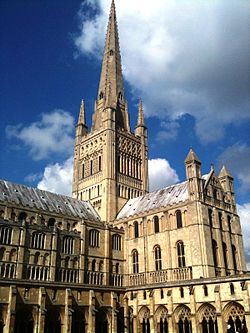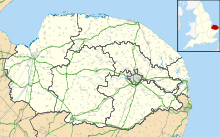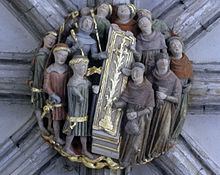- Norwich Cathedral
-
Norwich Cathedral Cathedral Church of the Holy and Undivided Trinity 
Spire and south transeptShown within Norfolk 52°37′55″N 1°18′04″E / 52.631944°N 1.301111°ECoordinates: 52°37′55″N 1°18′04″E / 52.631944°N 1.301111°E Location Norwich, Norfolk Country England Denomination Church of England Website www.cathedral.org.uk Architecture Style Norman, Gothic Years built 1096-1145 Specifications Length 140 metres (460 ft) Number of spires 1 Spire height 96 metres (315 ft) Administration Diocese Norwich (since 1095) Province Canterbury Clergy Dean The Very Rev. Graham C M Smith Laity Organist(s) David Dunnett Norwich Cathedral is a Church of England cathedral built in Norwich, Norfolk, dedicated to the Holy and Undivided Trinity.
The cathedral was started in 1096 and constructed out of flint and mortar and faced with a cream coloured Caen limestone. A Saxon settlement and two churches were demolished to make room for the buildings. The building was finished in 1145 and had the fine Norman tower, that we see today, topped with a wooden spire covered with lead. Several periods of damage caused rebuilding to the nave and spire but after many years the building was much as we see it now, from the final erection of the stone spire in 1480.
The large cloister has over 1,000 bosses including several hundred carved and ornately painted ones. The buildings are on the lowest part of the Norwich river plain and surrounded on three sides by hills and an area of scrubland, Mousehold heath, to the fourth and North direction. This means that the Cathedral could be seen from just about any location in the city.[citation needed]
It is also one of the Norwich 12 heritage sites.
Contents
Construction
Norwich Cathedral was built following the removal of the see to the city from Thetford. At the time of the Norman Conquest it had been at North Elmham.[1] The new cathedral incorporated a monastery of Benedictine monks.[2]
The structure of the cathedral is primarily in the Norman style, it having been constructed at the behest of Bishop Herbert de Losinga, who had bought the bishopric for £1900,[2] and retains the greater part of its original stone structure. Building started in 1096 and the cathedral was completed in 1145. It was built from flint and mortar and faced with cream coloured Caen limestone.[3] An Anglo-Saxon settlement and two churches were demolished to make room for the buildings and a canal cut to allow access for the boats bringing the stone and building materials which were taken up the Wensum and unloaded at Pulls Ferry, Norwich.[3]
The ground plan remains almost entirely as it was in Norman times, except for that of the easternmost chapel. The cathedral has an unusually long nave of fourteen bays, The transepts are without aisles, and the east end terminates in an apse with an ambulatory. From the ambulatory there is access to two chapels of unusual shape, the plan,of each being based on two intersecting circles.[1] This allows more correct orientation of the altars than in the more normal kind of radial chapel.
The crossing tower was the last piece of the Norman cathedral to be completed, in around 1140. It is boldly decorated with circles, lozenges and interlaced arcading. The present spire was added in the late fifteenth century, replacing one blown down in 1362. It is of brick faced with stone, supported on brick squinches built into the Norman tower. [1] The fall of the Norman spire caused considerable damage to the east end, as a result of which its clerestory was rebuilt in the Perpendicular style.[2][1]
The cathedral was damaged after riots in 1270, which resulted in the city paying heavy fines levied by Henry III, rebuilt by 1278 and re–consecrated by Edward I. [3]
A large cloister with over 1,000 bosses was started in 1297 and finally finished in 1430 after black death had plagued the city. The building was vaulted between 1416 and 1472 in a spectacular manner with hundreds of ornately carved, painted and gilded bosses. In 1463 the spire was struck by lightning and caused a fire to rage through the nave which was so intense it turned some of the creamy Caen limestone a pink colour.[3] In 1480 the Bishop of Norwich, James Goldwell, ordered the building of the stone spire which is still in place today, with flying buttresses later added to help support the roofs.
The total length of the building is 461 feet (140 m). Significant alterations from later periods include the 315 foot (96 m) spire and a two-storey cloister, the only such in England, as well as the vaults of the nave and chancel. Standing at 315 feet, the cathedral's spire is the second tallest in England, and dominates the city skyline — only the spire of Salisbury Cathedral is higher at 404 feet. Along with Salisbury and Ely the cathedral lacks a ring of bells which makes them the only three English cathedrals without them. One of the best views of the cathedral spire is from St. James's Hill on Mousehold Heath.
The bosses of the vault number over 1,000. Each is decorated with a theological image and have been described as without parallel in the Christian world. The nave vault shows the history of the world from the creation; the cloister includes series showing the life of Christ and the Apocalypse.
The precinct of the cathedral, the limit of the former monastery, is between Tombland (the Anglo-Saxon market place) and the River Wensum and the Cathedral Close, which runs from Tombland into the cathedral grounds, contains a number of interesting buildings from the 15th through to the 19th century including the remains of the infirmary.
The grounds also house the King Edward VI school, statues to the Duke of Wellington and Admiral Nelson and the grave of Edith Cavell.
17th century: hard times
The cathedral was partially in ruins when John Cosin was there at Grammar School in the early 17th century, and the former bishop was an absentee figure. During the reign of King Charles I, an angry Puritan mob invaded the cathedral and destroyed all Catholic symbols in 1643. The building, abandoned the following year, lay in ruins for two decades. Norwich Bishop Joseph Hall provides a graphic description from his book Hard Measure:
It is tragical to relate the furious sacrilege committed under the authority of Linsey, Tofts the sheriff, and Greenwood: what clattering of glasses, what beating down of walls, what tearing down of monuments, what pulling down of seats, and wresting out of irons and brass from the windows and graves; what defacing of arms, what demolishing of curious stone-work, that had not any representation in the world but of the cost of the founder and skill of the mason; what piping on the destroyed organ-pipes; vestments, both copes and surplices, together with the leaden cross which had been newly sawed down from over the greenyard pulpit, and the singing-books and service-books, were carried to the fire in the public market-place; a lewd wretch walking before the train in his cope trailing in the dirt, with a service-book in his hand, imitating in an impious scorn the tune, and usurping the words of the litany. The ordnance being discharged on the guild-day, the cathedral was filled with musketeers, drinking and tobacconing as freely as if it had turned ale-house.
Only at the Restoration in 1660 would the cathedral be restored under Charles II.
Modern works
In 2004 the new Refectory (winner, National Wood Awards 2004), by Hopkins Architects and Buro Happold opened on the site of the original refectory, on the south side of the cloister
Work on the new Hostry, also by Hopkins Architects started in April 2007 after the Cathedral Inspiration for the Future Campaign had reached its target of £10 million. It was opened by the Queen and Duke of Edinburgh on 4 May 2010. The new hostry has become the main entrance to the Cathedral which now has a £5 admission fee.
Misericords
Norwich Cathedral has a fine selection of 61 misericords, dating from 3 periods - 1480, 1515 and mid-19th century. The subject matter is varied, mythological, everyday subjects and portraits.
Gates
There are two gates to the cathedral grounds, both on Tombland (the pre-Norman marketplace). In 1420 Sir Thomas Erpingham, benefactor to the city, had the gate which bears his name built, sited opposite the west door of the cathedral leading into Cathedral Close.
The Cathedral Chapter
The Very Rev Graham Smith - Dean of Norwich
Rev Canon Jeremy Haselock - Precentor and Vice-Dean
Rev Canon Richard Capper - Canon Pastor
Rev Canon Dr Peter Doll - Canon Librarian
Rev Canon Philip McFadyen - Non Residentiary Canon (Priest in charge, St George, Colegate)
Dr Bryony Falkus - Lay Canon
Mrs Susie Furnivall - Lay Canon
The Cathedral Choirs
The Cathedral Choir is directed by David Lowe with David Dunnett as the organist. The Cathedral Choir consists of boys, girls and men. The boys of the Cathedral Choir hold places for around 16 boys aged from 7–13 years. The boys all attend Norwich School in the Cathedral Close, with at least 50% of their fees being paid by the Norwich Cathedral Endowment fund. With the men of the choir, the boys sing at six services a week and often more during special times of year such as Easter and Christmas. There are 12 men of the choir, six of them being choral scholars (often Music students from the University of East Anglia). The men of the choir sing with the boys' choir, but also sing fortnightly with the girls' choir at Tuesday evensong.
The girls of the Cathedral Choir were introduced in 1995 to give girls the chance to contribute to the musical life of the cathedral. It has places for 24 girls, who are older than the boys, at the secondary age of 11–18 years. The girls do not all attend the same school, instead coming from a wide variety of schools around Norwich and Norfolk. They sing evensong once weekly (alternately on their own and with the men of the Cathedral Choir) and at least one Sunday Eucharist a term. The girls sing more often during busy times of the year such as Easter and Christmas.
The choir sing at other churches around the diocese and further afield, release choral CDs, and go on music tours (sometimes all together and at others separately) - recent locations including the United States of America, Malta, Holland, and Norway,
Organists and Masters of the Music
- 1313 Adam the Organist
- 1424 Thomas Wath
- 1445 John Skarlette
- 1542 Thomas Grewe
- 1560 Edmund Inglott
- 1583 Thomas Morley
- 1593 William Baker
- 1594 Willim Cobbold
- 1608 William Inglott
- 1621 Richard Gibbs
- 1661 Richard Aylward
- 1664 Thomas Gibbs
- 1666 Richard Aylward
- 1670 Thomas Pleasants
- 1689 James Cooper
- 1721 Humphrey Cotton
- 1749 Thomas Garland
- 1808 John Christmas Beckwith
- 1809 John Charles Beckwith
- 1819 Zechariah Buck
- 1877 Francis Edward Gladstone
- 1881 Frederick Cook Atkinson
- 1885 Frank Bates
- 1928 Heathcote Dicken Statham
- 1967 Brian Runnett
- 1971 Michael Nicholas
- 1994 David Anthony Cooper
- 1995 Neil Taylor (Acting)
- 1996 David Dunnett
- 2007 David Lowe (Master of Music), David Dunnett continues as organist.
Assistant organists
- Zechariah Buck 1815 - 1819 (afterwards organist)
- Thomas Wolsey White
- George A. Löhr
- Alfred R. Gaul 1850s
- Frederick Cook Atkinson 1850s
- Edward Bunnett 1855 - 1877
- Arthur Henry Mann
- Philip Chignell
- Malcolm Archer 1978 - ????
- Adrian Lucas 1983 - 1990
- Neil Taylor 1990 - 1997 (afterwards organist of Sheffield Cathedral)
- Catherine Diennes
- Julian Thomas
- Ben Giddons
- Tom Primrose
Burials
- St William (of Norwich), Child Martyr (d 1144)
- John de Gray, Bishop of Norwich (1200–1214)
- Pandulf Masca, Roman ecclesiastical politician, papal legate to England and Bishop of Norwich (1215–1226)
- John Salmon, Lord Chancellor of England and Bishop of Norwich (1299–1325)
- Henry le Despenser, Bishop of Norwich (1370–1406)
- Richard Nykke, last Roman Catholic (before the Henrician reform) Bishop of Norwich (1501–1535)
- John Hopton, Bishop of Norwich (1554–1558)
- John Salisbury (bishop)
- John Parkhurst, Bishop of Norwich (1560–1575)
- John Overall (bishop), Bishop of Norwich (1618–1619)
- Richard Montagu, Bishop of Norwich (1638–1641)
- Edward Reynolds, Bishop of Norwich (1660–1676)
See also
- List of cathedrals in the United Kingdom
- Architecture of the medieval cathedrals of England
- English Gothic architecture
- Romanesque architecture
- Church of England
- List of the bishops of Norwich
Notes and references
- ^ a b c d Wilson, Bill; Pevsner, Nikolaus (2007). Norfolk 1: Norwich and North- East. Buildings of England (2nd ed.). New Haven: Yale University Press. pp. 189-193. ISBN 0 300 09607 0.
- ^ a b c Bumpus, T. Francis (1930). The Cathedrals of England and Wales. London: T. Werner Laurie. pp. 193–97.
- ^ a b c d "Timeline of Norwich Cathedral". Norwich Cathedral. http://www.cathedral.org.uk/historyheritage/timeline-timeline.aspx. Retrieved 26 July 2010.
- ^ Thornsby, Frederick W., ed. (1912) Dictionary of Organs and Organists. Bournemouth: Logan; p. 267
- ^ Thornsby (1912); p. 286
- ^ Thornsby (1912); p. 271
- ^ Who's Who in Music; 4th ed. 1962; p. 4
External links
See web-site: losinga.com for the full text of a controversial re-interpretation of the events surrounding the building of Norwich Cathedral in the new book: A Cautionary Landmark.
- Official site
- Herbert de Losinga
- A history of the choristers of Norwich Cathedral
- Bell's Cathedrals: The Cathedral Church of Norwich - from Project Gutenberg
- Flickr images tagged Norwich Cathedral
Cathedrals of the Church of England Province of
CanterburyBirmingham • Bristol • Bury St Edmunds • Canterbury • Chelmsford • Chichester • Coventry • Derby • Ely • Exeter • Gibraltar • Gloucester • Guildford • Hereford • Leicester • Lichfield • Lincoln • Norwich • Oxford (Christ Church) • Peterborough • Portsmouth • Rochester • St Albans • St Paul's (London) • Salisbury • Southwark • Truro • Wells • Winchester • WorcesterProvince of
YorkCategories:- Anglican cathedrals in England
- Buildings and structures in Norfolk
- Visitor attractions in Norfolk
- Grade I listed cathedrals
- Grade I listed buildings in Norfolk
- 1140s architecture
- Norman architecture
- English Gothic architecture
- Church of England churches in Norwich
- Monasteries in Norfolk
Wikimedia Foundation. 2010.







